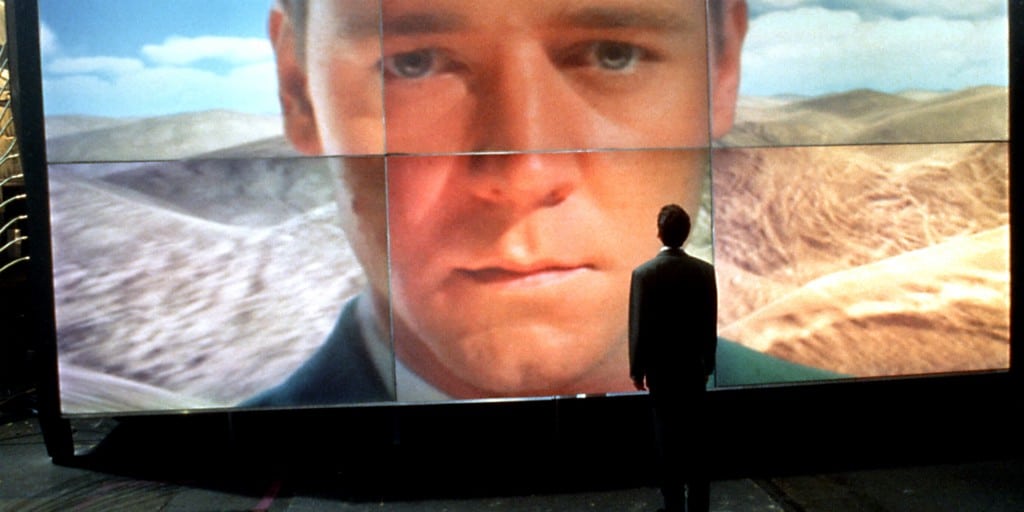Why the death of Hollywood might lead to the birth of something great.

Well, shit. While we were all spending our afternoons wading through political headlines, Hollywood up and died again. At least that’s the idea put forth in two competing articles in The New Yorker and Vanity Fair. According to Vanity Fair, the film industry is embarking upon its last gasp before technology renders cinema obsolete. According to The New Yorker, filmmakers will soon tackle interlocking and audience-driven narratives, with each member deciding for themselves the outcome of the films. It seems that both publications were waiting for the Sundance Film Festival high to wear off before reminding us not to get too attached to all those movies we just fell in love with.
And to be sure, both articles are thoughtfully written and meticulously researched, offering insights into the film industry that are well worth your time. There’s absolutely no denying that the old brick-and-mortar formula of exhibition is struggling. The numbers are revealing, and the Vanity Fair piece in particular has given us a lot of numbers. Profits are down. Corporate valuations are down. Audiences are down. These are the same numbers my wife throws in my face every time my daydream of building my own movie theater starts to veer a little too close to reality. At best, the old titans of exhibition can be seen as desperately swimming against a changing tide. At worst, cinema itself – as both an industry and an aesthetic – can be seen to be knocking on death’s door.
Dig a little deeper, though, and the history of various art forms isn’t one of obsolescence so much as perpetual transformation. Vanity Fair points to the recording industry as proof of a dying medium. Except according to The Washington Post, vinyl sales – vinyl sales! – eclipsed digital download in several countries around the world in 2016. Vanity Fair also points to the declining numbers of the publishing industry. Except according to Publishers Weekly, print book sales rose for the third straight year, with the largest gains being seen “in the adult nonfiction category.” And while newspapers as a whole may be down across the board, alternate sites of quality journalism – such as the rapidly expanding ProPublica – have risen to take their place.
Hollywood has undergone similar transformations in the past. Anyone who has ever taken a film history class knows that cinema has been pronounced dead before. Television killed cinema. Home video killed cinema. Censorship killed cinema. Corporate mergers killed cinema. Video games killed cinema. Every year, a handful of technology and entertainment publications run their take on why Hollywood is about to implode upon itself, and while they’re not wrong, they’re not exactly right, either. Cinema has always adjusted to meet the challenge of competition. When television brought media into every household in America, Hollywood pushed explicit and graphic content that couldn’t be broadcast into the home. When audiences grew tired of a homogenous studio project as a result of countless acquisitions and mergers, independent cinema became an industry unto itself.
And in many cases, success isn’t all it’s cracked up to be. As Vanity Fair notes, the things that make major companies successful also makes them slow. That article regularly points to Uber in his article as an example of a thriving Silicon Valley disruptor, but Uber has also seen setbacks in markets like Austin, Texas, where city regulations have created a void for local non-profits and independent contracts to step in. Meanwhile, recent negativity surrounding the company has caused countless people to swear off the app entirely. Whether they come back to Uber is another conversation entirely, but the enormous size of the company also makes it difficult for Uber to move with the agility of its smaller competitors.
Changing distribution patterns might even be good for the smaller distributors and theaters out there. A few weeks ago, I had the privilege of attending the annual Art House Convergence conference in Midway, Utah, a precursor to the Sundance Film Festival that focuses on independent exhibitors and distributors. People from all over the country traveled to Utah to discuss the disruptions their industry was facing, and formerly sacred cows – such as release windows – were the subject of much speculation. Some theater owners talked about their success in no longer booking films for full week-long engagements and instead splitting their screens among a handful of individual daily screenings of different films. Others expressed cautious optimism for services like MoviePass (despite their recent publicity issues). In the interest of serving their audiences, nothing was off the table.
Vanity Fair and The New Yorker are right to say that the current Hollywood model is in trouble, but as countless independent theaters have shown over the past decade, a loyal community with a little bit of purchasing power can be enough to keep a community theater thriving. Film may not always be the alpha male of audiovisual entertainment, but as long as independent filmmakers and creative exhibitors exist, it will always have a seat at the table. After all, if there’s room in 2017 for paperbacks and vinyl records to thrive, there will be room for film to offer itself as an alternative niche. The only true constant about people is that they crave variety; push too hard in any one direction, and you will still see people seeking out alternate forms of entertainment.
We may not be entirely comfortable with cinema’s next form – and many of the things we love about the industry may not survive the transition to bigger/small/more advanced/less advanced film – but we all hold the medium to be the important thing. I don’t necessarily believe that writing about film will be a viable outlet for all of my life, but I see too much innovation and too many dedicated film communities to think that I’ll ever be without challenging and beautiful art. Cinema is dead. Long live cinema.
Related Topics: Hollywood

